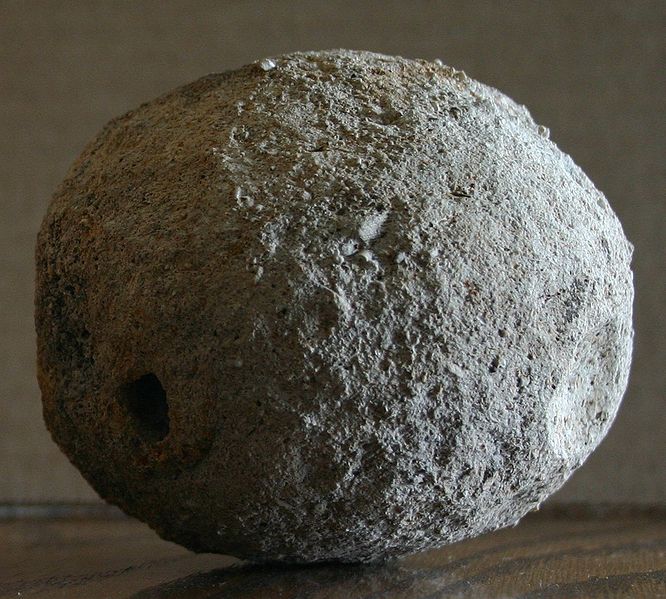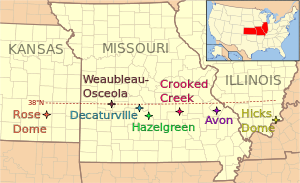Google offers this photo:
Thousands have been found in the vicinity, but they're rare elsewhere on Earth. The most common sizes run from golf-balls to grapefruit. Over the years, residents of Weaubleau and Osceola built stairways and walls from them.
Most are round or ovoid, a little flattened on one side. Cracking them open reveals that the bulk of each egg is chert, a hard, glossy sedimentary rock that results when silica replaces portions of calcium-carbonate limestone. Flint is one type of chert.
Weaubleau eggs often have a small piece of gray or greenish mudstone at the center, hence comparisons to eggs and their yolks. Sometimes the mudstone may hold the fossil of a conodont, a tiny, toothy eel.
Round rocks sometimes occur together in ancient gravel deposits. This geology paper on the Weaubleau crater calls them shale-filled paleokarst pockets. Here's a photo from that paper:
The current consensus among the rock-minded is that the round rocks originated with a meteorite impact circa 320-340 million years ago. Given that there are three non-concentric rings visible with synthetic-aperture radar, the cause may have been two or three serial impacts in close proximity. At any rate, something produced rings of shocked rock, the largest of which is about 12 miles in diameter.
Round rocks sometimes occur together in ancient gravel deposits. This geology paper on the Weaubleau crater calls them shale-filled paleokarst pockets. Here's a photo from that paper:
The current consensus among the rock-minded is that the round rocks originated with a meteorite impact circa 320-340 million years ago. Given that there are three non-concentric rings visible with synthetic-aperture radar, the cause may have been two or three serial impacts in close proximity. At any rate, something produced rings of shocked rock, the largest of which is about 12 miles in diameter.
Weaubleau counts as one of the Top 50 biggest meteor impacts detected on Earth, and offers more visible remnants than the average site.
There's another possible distinction, even rarer if confirmed. Weaubleau could be one of a near-linear string of craters along the 38th Parallel:
If these are not coincidental, the Weaubleau event would be part of the only known serial-meteorite-impact on Earth.
But this caveat: Planetary geologists say a serial impact on Earth is improbable. Given the Earth's relatively weak gravity well, compared to that of Jupiter, terrestial gravity is supposed to be too weak to break up even poorly cemented comets. So before agreeing, they'd want more proof that the 38th Parallel craters are of the same age.
But the Moon appears to have several crater strings from serial impacts, so it's not impossible.
But the Moon appears to have several crater strings from serial impacts, so it's not impossible.
Back to rock hunting. The best place to find a specimen is near the rim of the crater. North of Osceola, we turned off the main highway and found this estimable egg in a ditch:
It's a little more than seven inches in diameter, and weighs 13 pounds, so it's on the upper end of egg size. And no, we don't plan on breaking it open to see if there's a baby conodont fossil inside.
What would form such odd objects, and in such great numbers? One TV news account surmised that the eggs were formed immediately by the impact and flew like so many cannonballs from ground zero. More likely is that the impact threw out little pieces of mudstone from the crater that, in time, prompted chert formation. The phrase doesn't roll off the tongue like the term "cannonball," but rockhounds say that Weaubleau eggs are spherical nodules of chert that nucleated around siltstone clasts.





I have two almost perfectly round rocks that I found in my yard that were left by previous owners. I was at a loss and finally found some answers through your blog and research of flint nodules. One of mine is about 8" and the other close to 10" and they are very heavy. The previous owner did go to Missouri and Arkansas quite a bit so it makes sense that they probably picked them up for their garden and brought them back.
ReplyDeleteI live in Warsaw MO. and we have found tons of round rocks all mostly small some about half golf ball size around some smaller and some just a tad bigger. And these are on our property and our neighbors as well. I don't know much about them or if they are even worth anything. But my kids absolutely LOVE finding them!
ReplyDelete.
I have found one recently,just south of fordland.
ReplyDeleteI'm excavating for a new building and found it about 5 foot below surface.
It's about 7 inches diameter